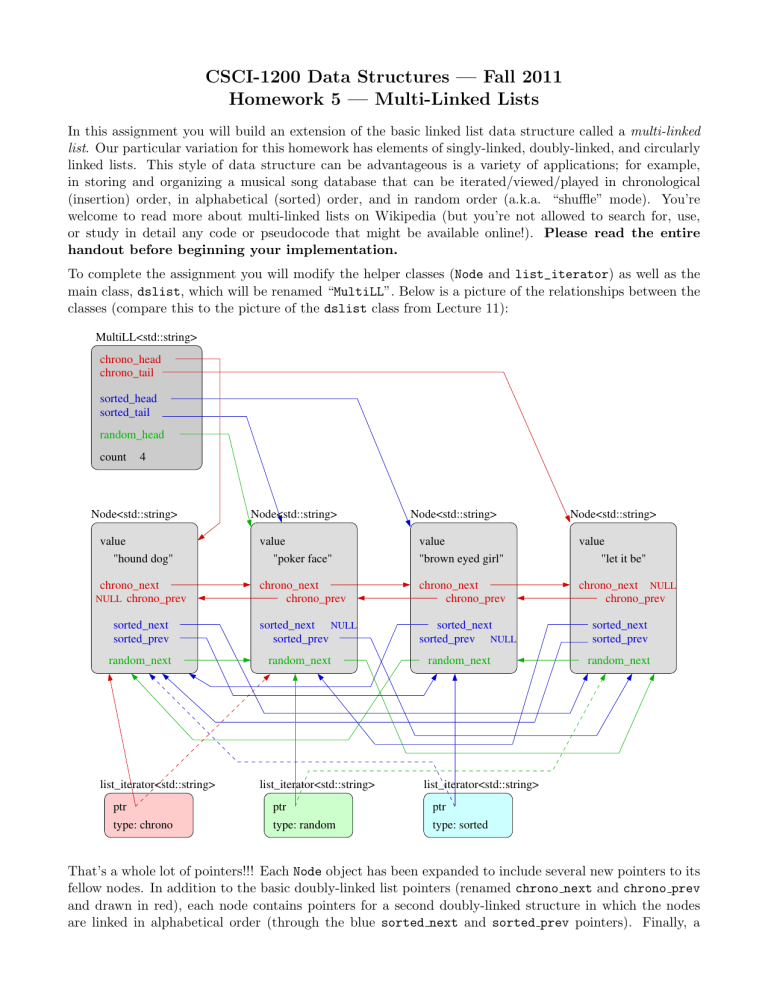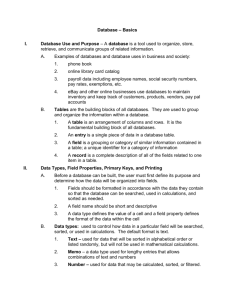Multi-Linked Lists

CSCI-1200 Data Structures — Fall 2011
Homework 5 — Multi-Linked Lists
In this assignment you will build an extension of the basic linked list data structure called a multi-linked list . Our particular variation for this homework has elements of singly-linked, doubly-linked, and circularly linked lists. This style of data structure can be advantageous is a variety of applications; for example, in storing and organizing a musical song database that can be iterated/viewed/played in chronological
(insertion) order, in alphabetical (sorted) order, and in random order (a.k.a. “shuffle” mode). You’re welcome to read more about multi-linked lists on Wikipedia (but you’re not allowed to search for, use, or study in detail any code or pseudocode that might be available online!).
Please read the entire handout before beginning your implementation.
To complete the assignment you will modify the helper classes ( Node and list_iterator ) as well as the main class, dslist , which will be renamed “ MultiLL ”. Below is a picture of the relationships between the classes (compare this to the picture of the dslist class from Lecture 11):
MultiLL<std::string> chrono_head chrono_tail sorted_head sorted_tail random_head count 4
Node<std::string> value
"hound dog" chrono_next
NULL chrono_prev sorted_next sorted_prev random_next
Node<std::string> value
"poker face" chrono_next chrono_prev sorted_next sorted_prev
NULL random_next
Node<std::string> value
"brown eyed girl" chrono_next chrono_prev sorted_next sorted_prev NULL random_next
Node<std::string> value
"let it be" chrono_next NULL chrono_prev sorted_next sorted_prev random_next list_iterator<std::string> ptr type: chrono list_iterator<std::string> ptr type: random list_iterator<std::string> ptr type: sorted
That’s a whole lot of pointers!!! Each Node object has been expanded to include several new pointers to its fellow nodes. In addition to the basic doubly-linked list pointers (renamed chrono next and chrono prev and drawn in red), each node contains pointers for a second doubly-linked structure in which the nodes are linked in alphabetical order (through the blue sorted next and sorted prev pointers). Finally, a
third order of the nodes is stored with a singly-linked, circular chain through the random next pointers
(in green). Note that the random ordering is re-created ( re-randomized ) each time a random iterator is requested/attached to the list.
These three orderings are maintained by the top level MultiLL object, and are accessed through appropriately named private head and tail pointers. Furthermore, because there are three different orderings, the iterator objects that attach to the MultiLL also include a type variable that is used when incrementing or decrementing the iterator to specify which of the three orderings should be followed. This type can be implemented as a custom enum type or with boolean values or an integer (your choice). In the diagram above, we show three iterators of different types attached to the list, as they would be initialized with the corresponding begin chronological() , begin sorted() , and begin random() function calls. The dashed lines illustrate where these iterators will move if they are pushed forward with the ++ increment operator (called separately on each iterator).
Node s can be inserted into the MultiLL using the add function. We specify that the new node is always inserted at the tail end of the chronological ordering, and the node is automatically inserted into the sorted list to maintain the consistent alphabetical ordering. The other common methods of adding elements to a linked list (e.g., push front , push back , and insert ) are not available in our MultiLL .
Just like regular linked lists, the MultiLL supports speedy erase operations of any Node from the beginning, middle, or end of the list. Of course, this involves a lot of pointer rearrangement! The erase operation is passed an iterator (of one of the three types), and after carefully removing the Node that the iterator points to, it returns an iterator of the same type, that points to the Node that is “next” in the order specified by that type.
Randomness
Each time the begin random() member function is called to attach a new iterator to the MLList , the singly-linked circular chain of random next pointers is re-randomized. The new ordering should be a proper random distribution; that is, each element in the list is equally likely to be chosen as the new head for the random ordering. And each remaining element is equally likely to be chosen as the “next” node after the head, etc. Finally, the last node in random order points back to the head node. All elements should appear in the circular list. Note that because this is a circular list, incrementing the random iterator can be done infinitely. The random order is generated once for the initial loop and the nodes simply repeat this same order on all subsequent loops.
Randomness is simulated by a computer using a pseudo-random number generator . The C library contains a few built-in options for generating random numbers, but we suggest you use the provided “Mersenne
Twister” code (see also http://en.wikipedia.org/wiki/Mersenne_twister ). To use, simply create a new MTRand object. Note that by default the MTRand object is “seeded” with the computer’s internal time (or other similar source), so that subsequent runs will be different. To extract a random number between 0 and n (inclusive), simply call the member function RandInt(int) on your MTRand object with the argument n . See the Mersenne Twister code for additional details and features. Note: You do not need to understand how this random number generator works to use it.
Your Tasks
Your new data structure should be a templated class named MultiLL and its public interface should support the following member functions: size , empty , clear , add , erase , begin_chronological , begin_sorted , begin_random , end_chronological , and end_sorted . The begin_chronological , begin_sorted , end_chronological , and end_sorted functions must run in constant time . Note that the running time of the begin_random function is not specified. The chronological and sorted iterators should support bi-directional movement (i.e., increment ++ and decrement -operations) and the random type iterator
2
should support the increment operator. All of these iterator operations should run in constant time . Note:
You should implement all standard class constructors, the assignment operator, and the destructor and these functions should properly allocate and deallocate the necessary dynamic memory. As with Homework
3, we will enable the homework server to give you the output from Valgrind for debugging memory usage and we will use Valgrind for grading as well. You are encouraged to use Valgrind or Dr. Memory on your local machine. Please ask the instructor or TAs for help if you have trouble installing or using these tools.
To get started, we highly recommend that you study and heavily borrow from the dslist class that we discussed in Lecture 11. The code is available on the course website. We provide a main.cpp
file that will exercise the required features of your class, but it does not include tests for each “corner” case . You should add your own test cases to the bottom of the main.cpp
file. Be sure to test every member function each of the constructors, the assignment operator, and the destructor, and exercise the templated class with types other than std::string . Discuss in your README.txt
file your strategy for thoroughly debugging your assignment.
In the implementation of the MLList class you may not use the STL list or the STL vector classes (or any other advanced STL container). You may only use the STL list and/or vector classes to aid in testing and debugging, in the main.cpp
file.
Order Notation and Iterator Invalidation Evaluation
You must follow the memory structure and performance requirements outlined in this handout for the
MLList class. Overall, you should pay attention to and strive for efficiency when implementing the data structure. However, for the basic assignment you are specifically encouraged to use a simple O ( n
2
) sorting algorithm such as insertion sort. What is the order notation of each of the member functions in your class?
Include your answers and discussion of this analysis in your README.txt
.
The interaction of active MLList iterators with the add and erase functions, and the simultaneous use of multiple MLList iterators on the same MLList object, may cause inconsistencies that are non-trivial, inefficient, and/or impossible to resolve. Think carefully about potential problems that might arise. In your README.txt
file discuss any restrictions you chose to place on the use of your class; specifically, if the user should be aware of the invalidation of active iterators during the use of specific member functions. Be sure to appropriately justify the need for these restrictions.
Extra Credit
Your order notation evaluation should have uncovered one function that will benefit from an improved sorting algorithm (something better than insertion sort). Which function? Caution, your overall class must still meet the performance requirements outlined above.
For one or two points of extra credit, identify this function. For several more points of extra credit re-implement this function to achieve a significant improvement in performance, correctly identifying the order notation of both your original and revised implementations. Discuss in your README.txt
.
Additional Information
Do all of your work in a new folder named hw5 inside of your homeworks directory. Use good coding style when you design and implement your program. Be sure to make up new test cases to fully test your program and don’t forget to comment your code! Use the template README.txt
to list your collaborators and any notes you want the grader to read. When you are finished please zip up your hw5 folder exactly as instructed for the previous assignments and submit it through the course webpage.
3



